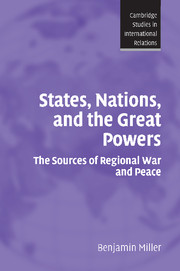Book contents
- Frontmatter
- Contents
- List of figures
- List of tables
- Preface and acknowledgments
- 1 Why some regions are peaceful and others are not
- 2 A theory of regional war and peace
- 3 States, nations, and war
- 4 Explaining the war proneness of the Middle East
- 5 The great powers war and peace in the Middle East
- 6 War and peace in the Balkans: states, nations, and great powers
- 7 The state-to-nation balance and the emergence of peace in South America during the twentieth century
- 8 The emergence of high-level peace in post-1945 Western Europe: nationalism, democracy, hegemony, and regional integration
- 9 Conclusions
- Appendix A Comparative dimensions of the state-to-nation imbalance in the Middle East, the Balkans, South America, and Western Europe in the post-1945 era
- Appendix B Data-file: major armed conflicts/wars by region, type, and modes of great power regional involvement (1945–2004)
- Bibliography
- Index
- Cambridge Studies in International Relations
Preface and acknowledgments
Published online by Cambridge University Press: 22 September 2009
- Frontmatter
- Contents
- List of figures
- List of tables
- Preface and acknowledgments
- 1 Why some regions are peaceful and others are not
- 2 A theory of regional war and peace
- 3 States, nations, and war
- 4 Explaining the war proneness of the Middle East
- 5 The great powers war and peace in the Middle East
- 6 War and peace in the Balkans: states, nations, and great powers
- 7 The state-to-nation balance and the emergence of peace in South America during the twentieth century
- 8 The emergence of high-level peace in post-1945 Western Europe: nationalism, democracy, hegemony, and regional integration
- 9 Conclusions
- Appendix A Comparative dimensions of the state-to-nation imbalance in the Middle East, the Balkans, South America, and Western Europe in the post-1945 era
- Appendix B Data-file: major armed conflicts/wars by region, type, and modes of great power regional involvement (1945–2004)
- Bibliography
- Index
- Cambridge Studies in International Relations
Summary
This book investigates the origins of regional war and peace. My interest in this subject can be traced back to the first day of a major regional war in which I actively took part as a very young soldier — the 1973 Yom Kippur War. On the first day of that war I found myself engaged in tank battles with Syrian forces and in the early morning of the day after I — together with a few other Israeli soldiers — was surrounded by a major Syrian armored force in a very small bunker in the southern part of the Golan Heights.
I will not go here into the details of the very frightening experience in that bunker and following experiences later in the war. But such traumatic events have left me with a strong desire to look for an explanation for the occurrence of armed conflicts, notably those which escalate to large-scale violence, and how to manage, reduce, or overcome such conflicts and to move from war to peace.
As a student of Kenneth Waltz at the University of California, Berkeley, I fully realized the importance of the international system, and specifically the great powers and their influence on a great variety of events in world politics. Thus, my first book focused on the sources of conflict and cooperation among the great powers.
- Type
- Chapter
- Information
- States, Nations, and the Great PowersThe Sources of Regional War and Peace, pp. xiv - xviiiPublisher: Cambridge University PressPrint publication year: 2007

